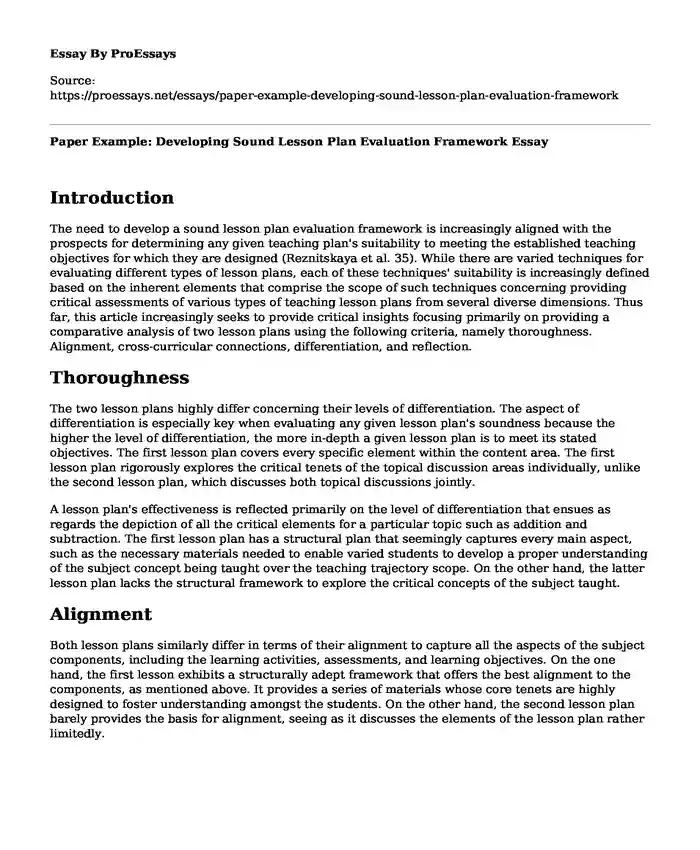Introduction
The need to develop a sound lesson plan evaluation framework is increasingly aligned with the prospects for determining any given teaching plan's suitability to meeting the established teaching objectives for which they are designed (Reznitskaya et al. 35). While there are varied techniques for evaluating different types of lesson plans, each of these techniques' suitability is increasingly defined based on the inherent elements that comprise the scope of such techniques concerning providing critical assessments of various types of teaching lesson plans from several diverse dimensions. Thus far, this article increasingly seeks to provide critical insights focusing primarily on providing a comparative analysis of two lesson plans using the following criteria, namely thoroughness. Alignment, cross-curricular connections, differentiation, and reflection.
Thoroughness
The two lesson plans highly differ concerning their levels of differentiation. The aspect of differentiation is especially key when evaluating any given lesson plan's soundness because the higher the level of differentiation, the more in-depth a given lesson plan is to meet its stated objectives. The first lesson plan covers every specific element within the content area. The first lesson plan rigorously explores the critical tenets of the topical discussion areas individually, unlike the second lesson plan, which discusses both topical discussions jointly.
A lesson plan's effectiveness is reflected primarily on the level of differentiation that ensues as regards the depiction of all the critical elements for a particular topic such as addition and subtraction. The first lesson plan has a structural plan that seemingly captures every main aspect, such as the necessary materials needed to enable varied students to develop a proper understanding of the subject concept being taught over the teaching trajectory scope. On the other hand, the latter lesson plan lacks the structural framework to explore the critical concepts of the subject taught.
Alignment
Both lesson plans similarly differ in terms of their alignment to capture all the aspects of the subject components, including the learning activities, assessments, and learning objectives. On the one hand, the first lesson exhibits a structurally adept framework that offers the best alignment to the components, as mentioned above. It provides a series of materials whose core tenets are highly designed to foster understanding amongst the students. On the other hand, the second lesson plan barely provides the basis for alignment, seeing as it discusses the elements of the lesson plan rather limitedly.
Cross-Curricular Connections
Both lesson plans lack a suitable framework that supports the cross-curriculum interconnectedness between and amongst varied disciplines. The tutors are tasked with suitable techniques for incorporating the present subject conceptual frameworks into other seemingly important disciplines for prospects.
Differentiation
Differentiation is a key tenet in a lesson plan (Reznitskaya et al. 35). The first lesson plan rigorously explores the critical tenets of the topical areas of discussion individually, unlike the second lesson plan, which discusses both topical discussions jointly. The effectiveness of a lesson plan is reflected primarily on the level of differentiation that ensues as regards the depiction of all the critical elements for a particular topic such as addition and subtraction. The first lesson plan has a structural plan that seemingly captures every main aspect, such as the necessary materials needed to enable varied students to develop a proper understanding of the subject concept being taught over the scope of the teaching trajectory.
Reflection
The first lesson plan offers several diverse questions on which to conduct assessments by the students to establish their level of understanding of the key concepts thus far. The second lesson plan barely provides this framework, as shown by its lack of assessment questions that provide the students with a basis to assess their understanding of the key concepts thus far.
Work Cited
Reznitskaya, Alina, and Ian AG Wilkinson. "Truth matters: Teaching young students to search for the most reasonable answer." Phi Delta Kappan 99.4 (2017): 33-38.
Cite this page
Paper Example: Developing Sound Lesson Plan Evaluation Framework. (2023, Oct 29). Retrieved from https://proessays.net/essays/paper-example-developing-sound-lesson-plan-evaluation-framework
If you are the original author of this essay and no longer wish to have it published on the ProEssays website, please click below to request its removal:
- Essay Incident That Changed My Life
- Should College Football Athletes Be Paid?
- Essay Sample on Inclusion as a Reasonable Approach to Teaching
- Narrative Essay on About Myself
- Life Changing Experience Essay Sample
- Essay Example on Playing Basketball: A Popular Way of Recreation for Chinese Students
- My life of Reading - Free Essay Example







